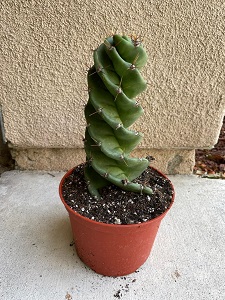Growing Spiral Cactus: A Captivating Addition to Your Indoor Garden
What is a Spiral Cactus?
Spiral cactus, scientifically known as Mammillaria gracilis fragilis, are unique and visually stunning plants belonging to the Cactaceae family. These charming succulents are characterized by their distinctive spiral-shaped arrangement of tubercles and spines, which creates an intriguing visual effect. The spiral cactus is native to Mexico and thrives in arid and semi-arid regions.
Choosing the Right Spiral Cactus: Varieties and Care Tips
Types of Spiral Cacti
There are several popular varieties of spiral cacti, each with its own unique characteristics. The most common variety is Mammillaria gracilis fragilis, known for its delicate appearance and spiral growth pattern. Other noteworthy varieties include the Mammillaria elongata, which features longer tubercles, and the Mammillaria polyedra, which has a more pronounced spiral arrangement.
Ideal Growing Conditions
To ensure the healthy growth of your spiral cactus, it is crucial to provide it with the right growing conditions. These plants thrive in well-draining soil with a slightly acidic to neutral pH. Additionally, they prefer warm temperatures ranging from 65°F to 80°F (18°C to 27°C).
Sunlight Requirements
Spiral cacti are desert plants and require plenty of sunlight to thrive. It is best to place them in a location where they can receive at least six hours of direct sunlight per day. However, be cautious of the intense midday sun, as it can cause sunburn. If growing indoors, place your spiral cactus near a south-facing window to maximize light exposure.
Soil and Watering Needs
The soil for spiral cacti should be well-draining to prevent waterlogging, as excessive moisture can lead to root rot. A recommended potting mix consists of a combination of cactus soil, perlite, and coarse sand to ensure proper drainage. When watering, allow the soil to dry out between each watering session. During the winter months, reduce the watering frequency to mimic the plant’s natural dormancy period.
Planting and Propagation Techniques for Spiral Cacti
Planting Spiral Cacti
When planting spiral cacti, it is essential to choose a suitable pot or container. Opt for a container with drainage holes to prevent water accumulation. Fill the pot with the aforementioned well-draining soil mixture and gently place the cactus inside, ensuring that it sits upright and the roots are well-covered.
Potting Mix and Containers
A well-draining potting mix is crucial for spiral cacti to thrive. You can create your own mix by combining cactus soil, perlite, and coarse sand in a 1:1:1 ratio. As for containers, select one that provides enough space for the cactus to grow and has adequate drainage.
Watering and Drainage
Proper watering and drainage are vital to the health of your spiral cactus. Water the plant thoroughly but infrequently, allowing the soil to dry out between waterings. Always check the soil moisture level before watering. When watering, pour water directly onto the soil and avoid wetting the spines and tubercles to prevent rot. Ensure that the container has sufficient drainage to allow excess water to escape.
Propagation Methods
Spiral cacti can be propagated through several methods, including seed propagation and offset division. Seeds can be collected from mature cacti and sown in a well-draining soil mix. Offsets, or “pups,” can be carefully separated from the parent plant and planted in individual pots. Both methods require patience and attention to detail, but with proper care, successful propagation can be achieved.
Caring for Spiral Cacti: Essential Maintenance Practices
Temperature and Humidity Considerations
Spiral cacti are adapted to arid environments and are accustomed to warm temperatures and low humidity. Maintain a temperature range of 65°F to 80°F (18°C to 27°C) for optimal growth. Avoid exposing the cactus to extreme temperature fluctuations or drafts, as they can stress the plant. In terms of humidity, these plants prefer low humidity levels, making them well-suited for indoor environments.
Pruning and Trimming
Pruning and trimming are essential maintenance practices for spiral cacti. Use clean, sharp scissors or pruning shears to remove any dead or damaged parts of the plant. Trimming can also help maintain the desired shape and size of the cactus. Be cautious when handling the cactus due to its spines, and use protective gloves if necessary.
Fertilizing and Feeding
Spiral cacti have relatively low nutrient requirements. During the active growing season, which typically occurs in spring and summer, you can apply a balanced cactus fertilizer diluted to half strength. Remember to follow the instructions on the fertilizer package and avoid overfertilization, as it can harm the plant. During the dormant period in winter, refrain from fertilizing.
Pests and Diseases
While spiral cacti are generally resilient to pests and diseases, they can occasionally face challenges. Common pests that may affect these cacti include mealybugs and spider mites. Regularly inspect your plants for any signs of infestation, such as white cottony masses or webbing. If detected, treat the affected plants with an appropriate insecticidal soap or consult with a horticulturist for further guidance.
Common Problems and Troubleshooting
Overwatering and Root Rot
Overwatering is one of the most common problems encountered when growing spiral cacti. To prevent root rot, ensure that the soil is well-draining and allow it to dry out between waterings. If you suspect overwatering or root rot, gently remove the cactus from the pot, trim any affected roots, and replant it in fresh, well-draining soil.
Sunburn and Heat Stress
Intense sunlight can cause sunburn and heat stress to spiral cacti. If you notice discoloration, browning, or wilting of the plant, it may be experiencing sunburn. To protect your cactus, provide some shade during the hottest part of the day, particularly in regions with scorching summers.
Pest Infestations
Mealybugs and spider mites are common pests that can infest spiral cacti. If you detect signs of infestation, such as small webs or cottony masses, take immediate action. Use a mild insecticidal soap or horticultural oil to eliminate the pests. Regularly inspect your plants to catch infestations early and prevent them from spreading.
Frequently Asked Questions (FAQs)
Can I grow a spiral cactus indoors?
Yes, spiral cacti can be grown indoors. Ensure that they receive ample sunlight by placing them near a south-facing window. Additionally, maintain a warm and dry environment, as these cacti prefer low humidity.
How often should I water my spiral cactus?
Water your spiral cactus thoroughly but infrequently. Allow the soil to dry out between waterings and adjust the frequency based on environmental conditions. During the dormant winter period, reduce watering to prevent overhydration.
How can I prevent pests from attacking my spiral cactus?
To prevent pests, regularly inspect your plants for any signs of infestation. Maintain good hygiene by removing fallen debris and keeping the surrounding area clean. If necessary, use mild insecticidal soaps or oils to control pests.
Is it possible to propagate a spiral cactus from cuttings?
While spiral cacti can be propagated from cuttings, they are more commonly propagated from offsets or seeds. Cuttings can be challenging to root, and success rates may vary.
What should I do if my spiral cactus starts to rot?
If your spiral cactus shows signs of rot, such as soft and discolored areas, take immediate action. Carefully remove the affected parts, allowing the healthy tissue to callus. Replant the cactus in fresh, well-draining soil, and adjust your watering practices to prevent further rot.
Conclusion
Growing spiral cacti can be a rewarding experience, thanks to their unique and captivating appearance. By selecting the right variety, providing ideal growing conditions, and implementing proper care practices, you can enjoy the beauty of these fascinating cacti. Remember to monitor watering, protect them from extreme temperatures, and be vigilant against pests. With patience and attention, your spiral cactus can thrive and become a stunning addition to your indoor or outdoor garden.
Read More: Growing Dragon Breath Plants
Read more: Growing Musa Basjoo Indoors











